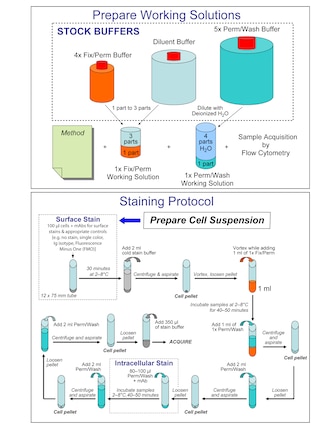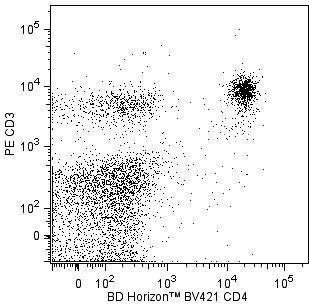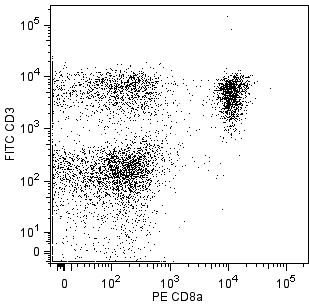Old Browser
This page has been recently translated and is available in French now.
Looks like you're visiting us from {countryName}.
Would you like to stay on the current country site or be switched to your country?




Flow cytometric analysis of Zbtb7b (ThPOK) expression in C57BL/6 mouse thymocytes and lymph node cells. Thymocytes (Panel 1) or Lymph Node Cells (Panels 2 and 3) were stained with BD Horizon™ BV421 Rat Anti-Mouse CD4 (Cat No. 562891) and PE Rat Anti-Mouse CD8a (Cat. No. 553033/553032/561095) antibodies. The cells were fixed and permeabilized with the BD Pharmingen™ Transcription Factor Buffer Set (Cat. No. 562574/562725) and stained with either Alexa Fluor® 647 Rat IgG2b, κ Isotype Control (Cat. No. 557691) or Alexa Fluor® 647 Rat Anti-Mouse Zbtb7b (ThPOK) (Cat. No. 565500) antibody. Two-color flow cytometric contour plots showing the correlated expression of Zbtb7b (ThPOK) [or Ig Isotype control staining] versus CD8a (Panel 1, Thymocytes) or CD4 (Panel 2, Lymph Node Cells) were derived from gated events with the forward and side light-scatter characteristics of intact cells. The fluorescence histograms (Panel 3, Lymph Node Cells) showing Zbtb7b (ThPOK) expression in CD4+ (solid line histogram) versus CD8+ cells (dashed line histogram) were derived from CD4+CD8- or CD4-CD8+ gated events, respectively, with the light-scatter characteristics of intact lymphocytes. Alternatively, Lymph Node Cells (Panel 4) were similarly fixed, permeabilized, and stained with PE Mouse Anti-RUNX3 (Cat. No. 564814) and Alexa Fluor® 647 Rat Anti-Mouse Zbtb7b (ThPOK) antibodies. The two-color flow cytometric contour plot showing the correlated expression of Zbtb7b (ThPOK) versus RUNX3 was derived from gated events with the light-scatter characteristics of intact lymphocytes. Flow cytometric analysis was performed using a BD LSRFortessa™ Flow Cytometer System.


BD Pharmingen™ Alexa Fluor® 647 Rat Anti-Mouse Zbtb7b (ThPok)

Regulatory Status Legend
Any use of products other than the permitted use without the express written authorization of Becton, Dickinson and Company is strictly prohibited.
Preparation And Storage
Product Notices
- This reagent has been pre-diluted for use at the recommended Volume per Test. We typically use 1 × 10^6 cells in a 100-µl experimental sample (a test).
- Please refer to www.bdbiosciences.com/us/s/resources for technical protocols.
- The Alexa Fluor®, Pacific Blue™, and Cascade Blue® dye antibody conjugates in this product are sold under license from Molecular Probes, Inc. for research use only, excluding use in combination with microarrays, or as analyte specific reagents. The Alexa Fluor® dyes (except for Alexa Fluor® 430), Pacific Blue™ dye, and Cascade Blue® dye are covered by pending and issued patents.
- Alexa Fluor® 647 fluorochrome emission is collected at the same instrument settings as for allophycocyanin (APC).
- Alexa Fluor® is a registered trademark of Molecular Probes, Inc., Eugene, OR.
- Caution: Sodium azide yields highly toxic hydrazoic acid under acidic conditions. Dilute azide compounds in running water before discarding to avoid accumulation of potentially explosive deposits in plumbing.
- For fluorochrome spectra and suitable instrument settings, please refer to our Multicolor Flow Cytometry web page at www.bdbiosciences.com/colors.
- Source of all serum proteins is from USDA inspected abattoirs located in the United States.
- An isotype control should be used at the same concentration as the antibody of interest.
Companion Products






The T43-94 monoclonal antibody specifically recognizes mouse Zinc finger and BTB domain-containing protein 7B (Zbtb7b) which is also known as, T-helper-inducing POZ/Krueppel-like factor (Th-POK), Krueppel-related zinc finger protein cKrox (cKrox), or Zinc finger protein 67 (Zfp67). Zbtb7b is a Zn2+ finger-containing transcription factor that acts as a transcriptional repressor or activator in a promoter-dependent manner. Zbtb7b plays a role in thymic selection of T cells and is expressed in CD4+CD8+ thymocytes and mature CD4+CD8- thymocytes and T cells. It is not expressed by mature CD4-CD8+ thymocytes and T cells. It indirectly increases the expression of CD4 in developing T cells by antagonizing Runx-3-mediated CD4 repression. Zbtb7b expression has also been found in NKT and gamma/delta T cells. Zbtb7b plays a role in transcriptional repression of collagen gene expression as well.
Development References (4)
-
Kappes DJ. Expanding roles for ThPOK in thymic development. Immunol Rev. 2010; 238(1):182-194. (Biology). View Reference
-
Luckey MA, Kimura MY, Waickman AT, Feigenbaum L, Singer A, Park JH. The transcription factor ThPOK suppresses Runx3 and imposes CD4(+) lineage fate by inducing the SOCS suppressors of cytokine signaling. Nat Immunol. Nat Immunol. 2014; 15(7):638-645. (Biology). View Reference
-
Reis BS, Rogoz A, Costa-Pinto FA, Taniuchi I, Mucida D. Mutual expression of the transcription factors Runx3 and ThPOK regulates intestinal CD4(+) T cell immunity. Nat Immunol. 2013; 14(3):271-280. (Biology). View Reference
-
Taniuchi I, Ellmeier W. Transcriptional and epigenetic regulation of CD4/CD8 lineage choice. Adv Immunol. 2011; 110:71-110. (Biology). View Reference
Please refer to Support Documents for Quality Certificates
Global - Refer to manufacturer's instructions for use and related User Manuals and Technical data sheets before using this products as described
Comparisons, where applicable, are made against older BD Technology, manual methods or are general performance claims. Comparisons are not made against non-BD technologies, unless otherwise noted.
For Research Use Only. Not for use in diagnostic or therapeutic procedures.
Report a Site Issue
This form is intended to help us improve our website experience. For other support, please visit our Contact Us page.